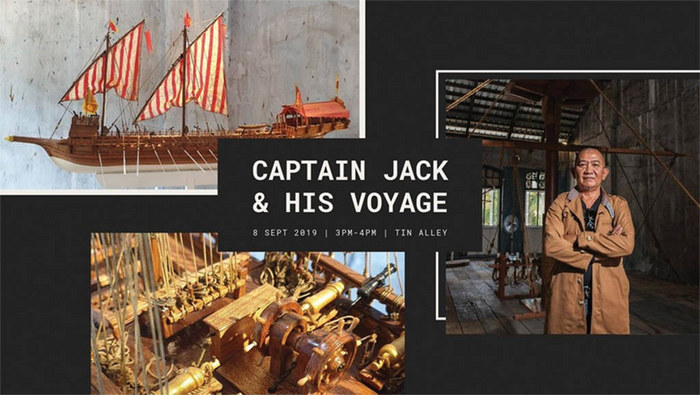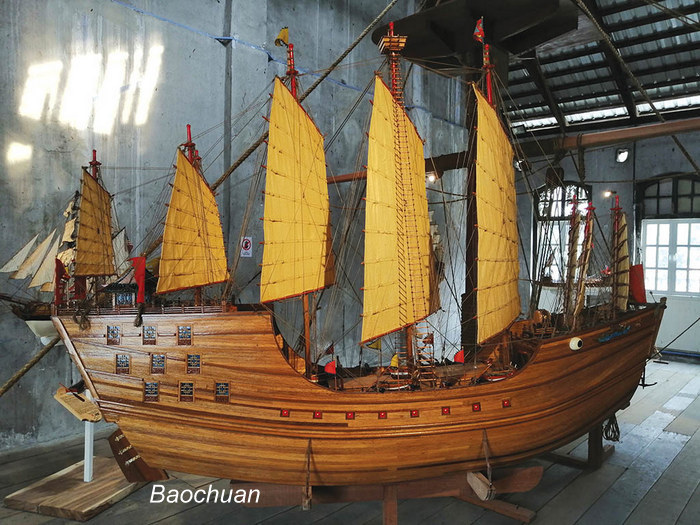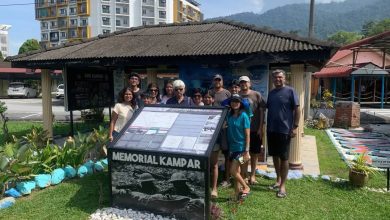A Voyage of Passion


By Chris Teh
We don’t know how long it took for Admiral Cheng Ho to sail from China to Melaka but it takes Azhar Kamaruddin, better known as Captain Jack to many, as long as six months to craft one of his ship replicas with its exacting details.
“The Baochuan replica was originally built in the Ming Dynasty in 1403. It was used by Admiral Cheng Ho who led seven voyages in pursuit of diplomacy until his demise sometime between 1433 to 1435,” Azhar explained. “It is characterised by its 3-level deck and Cheng Ho’s vigil at the front section resembling a mix between tiger and dragon. I crafted this replica in 2012.”
This replica is now on display at Tin Alley as one of the installations for Art Ipoh 2019. Located in between Tin Alley’s main unit and the last shophouse, these ship replicas are situated on the first floor. After reaching the level climbing up the stairs, the sail immediately catches the eye and it feels as if one is walking on a ship’s plank!
Other replicas crafted by Captain Jack include the Baltimore Clipper, 18th Century British Royal Navy and the Mediterranean Galley.
“The Baltimore Clipper was built around the coastal area of the United States and the Caribbean Islands. It was used for the War of 1812. I crafted this replica in 2015,” he said.
Captain Jack has been crafting ship replicas for 10 years in his workshop at Batu Gajah.
Explaining his passion for crafting ship replicas, Captain Jack said, “I was a visual merchandising artist for Parkson and got transferred to many places around the country. It was not what I truly wanted. Therefore, I resigned from that job in 1997 and entered the industrial line to learn the skills and techniques needed for my ship replica crafting later,” he said.
Requiring at least half a year to complete a 6-foot-long ship replica project, Azhar said the size of replicas he makes get bigger and bigger each year.
“It does sound tiring. I have to pay attention to every intricate detail of the ship and each part of the ship. My crafted replicas have to resemble around 90% of the original ships built in their respective eras,” he bemoaned. “But when you work on your passion, it is not tiring at all. In fact, I just want to keep doing more.”
Asked on how he inspires himself, Azhar said that he reads many historical books about ships and the era associated with a particular ship.
“In order for me to fully get the feel of how a ship was built back then, I have to immerse myself in the era,” he explained. “It’s not only the ship. The era is equally as important too. Thus, whenever I watch classic Chinese movies or dramas, I focus not on the actors and scripts but the surrounding that is depicted. Apart from written materials and pictures, those are the closest I can get to obtain an accurate overview of the past.”
Explaining further, Azhar said, “I don’t want to mass-produce ship models and sell them off. That is not why I chose to stay in this artistic line. What I do is I learn from history, carve them out in my piece and show to the public what I want them to see. Some parts of the ships I crafted can be moved freely, as intended, like the original ships do.”
The British Royal Navy was originally built in the early 18th century. Describing the characteristics of the ship, Azhar elaborated, “The Royal Navy had a rating system to categorise sailing warships. In this particular display, it is a second-rate ship, where it consisted of 90 cannons weighing from 12 to 32 pounders on three gun decks. I crafted this replica in 2016.”
Easily mistaken for country flags, he clarified that the flags were the signalling medium in case of distress.
“Each flag represented an alphabet or number,” he said. “Back in those days, there weren’t any electronic devices they could use. Flags like this were one of the few materials suitable for communication.”
The Mediterranean Galley was originally built by civilisations of the Mediterranean Sea in the late second millennium B.C., remaining in use until the early 19th century.
“Galleys utilised favourable wind directions, but it was mainly propelled by rowing,” Azhar highlighted. “I crafted this replica in 2017.”
Crafting replicas is not exactly a lucrative profession and Captain Jack does not earn much from his trade.
“But for me, it’s not about money. Nor is it about getting fame or materialistic achievement,” Azhar said.
“I love history, especially ones where ships were representative of their eras. As an artist, it is a common practice to use my sixth sense to imagine how ships would’ve been constructed in those eras. I integrate that into my replica crafting,” he stressed. “In my opinion, history involves every country in this world as it is now. It was never one-sided. This is what I want to share with the younger generation today.”
“I firmly believe each and every living soul in this world has a purpose. I have found my purpose, which is to share and retell accurate history through ship-replica crafting,” Azhar opined.
Expressing his gratitude, Azhar said, “I really have Mr Tan Kai Lek, Mr Philip Wong and his team to thank for their efforts in making Tin Alley and Art Ipoh a great success. Ipoh needs more art exhibitions like this to not only expand the public’s knowledge and definition of art but also in the hopes that they learn the history and the lesson behind each and every installation art piece.”




